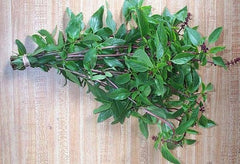Basil Gardening
 This garden favorite is easy to grow and versatile in so many dishes, make sure you plant lots because you’ll always find a use for it! Basil can be started from seed directly in the garden but will take some time to harvest. Planting from seedling will give you quicker results. Basil prefers full sun, well-drained but consistently moist soil, and needs warmth to grow. If your soil dries out quickly, mulch around the base of the plant (be sure to choose organic mulch!). It does have a tendency to flower so be sure to trim off blossoms to promote growth (they are edible!). Not fussy, basil just needs regular watering and occasional fertilizer. The more you harvest, the faster it grows and will keep producing until the first heavy frost.
This garden favorite is easy to grow and versatile in so many dishes, make sure you plant lots because you’ll always find a use for it! Basil can be started from seed directly in the garden but will take some time to harvest. Planting from seedling will give you quicker results. Basil prefers full sun, well-drained but consistently moist soil, and needs warmth to grow. If your soil dries out quickly, mulch around the base of the plant (be sure to choose organic mulch!). It does have a tendency to flower so be sure to trim off blossoms to promote growth (they are edible!). Not fussy, basil just needs regular watering and occasional fertilizer. The more you harvest, the faster it grows and will keep producing until the first heavy frost.
Basil does not have many problems but will occasionally get aphids, fusarium or bacterial wilt, mildew, and leaf spots. These are all easily avoided and handled so don’t be deterred from grow this great garden addition. This fantastic article from Clemson University Extension office covers common Basil problems in more detail.
Fun Basil Facts!
 Mosquitoes hate the scent! Especially Lemon Basil and Cinnamon Basil – combine a few plants in your patio containers to keep the bugs away. The full foliage makes a nice addition to containers; just rustle the leaves for a burst of scent; and you’ll have ready access to herbs for dinner. Old-time gardeners always planted basil near tomatoes, peppers, and asparagus to repel thrips and beetles. Folklore also goes that basil planted near tomatoes make the fruit sweeter. Definitely worth a try and you’ll need both ingredients for our killer Caprese recipe (here).
Mosquitoes hate the scent! Especially Lemon Basil and Cinnamon Basil – combine a few plants in your patio containers to keep the bugs away. The full foliage makes a nice addition to containers; just rustle the leaves for a burst of scent; and you’ll have ready access to herbs for dinner. Old-time gardeners always planted basil near tomatoes, peppers, and asparagus to repel thrips and beetles. Folklore also goes that basil planted near tomatoes make the fruit sweeter. Definitely worth a try and you’ll need both ingredients for our killer Caprese recipe (here).
Harvesting and Cooking with Basil
 Basil can be harvested as needed but try to pick in the morning as the taste will be the sweetest. To pick, just snip leaves off the plant or cut a whole stem (the latter will cause plant to bush out more). Rinse leaves in cool water and spread on towels or use a salad spinner to dry out. If you aren’t using right away, submerge stems in water as with a flower bouquet until ready to use. Do not store in the refrigerator as this will affect taste. To strip leaves off stems, just hold upside and run fingers down the length of the branch.
Basil can be harvested as needed but try to pick in the morning as the taste will be the sweetest. To pick, just snip leaves off the plant or cut a whole stem (the latter will cause plant to bush out more). Rinse leaves in cool water and spread on towels or use a salad spinner to dry out. If you aren’t using right away, submerge stems in water as with a flower bouquet until ready to use. Do not store in the refrigerator as this will affect taste. To strip leaves off stems, just hold upside and run fingers down the length of the branch.
Basil is best used fresh and does not hold up well to cooking heat (so add to dishes at the very end of cooking time). It can be dried in a dehydrator or frozen for later use in marinades or sauces. To freeze basil, pack ice cube trays with chopped leaves and fill with olive oil – when thawed they make a great addition to dressings or sauces. Basil is also a great mix in to marinades, can be steeped in vinegar, and is a nice complement with “bitter” salad greens such as arugula.
Browse our selection of basil (and other herbs) here:
